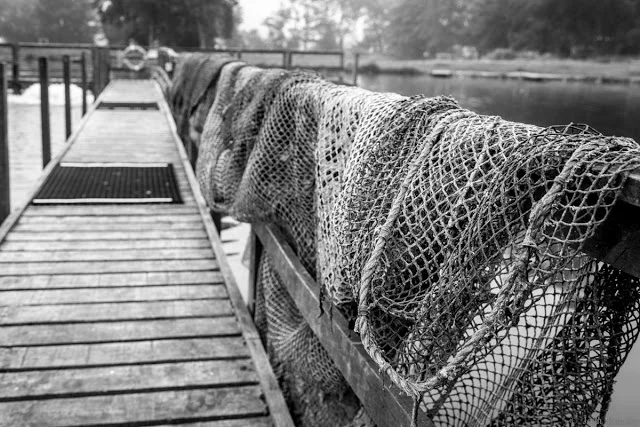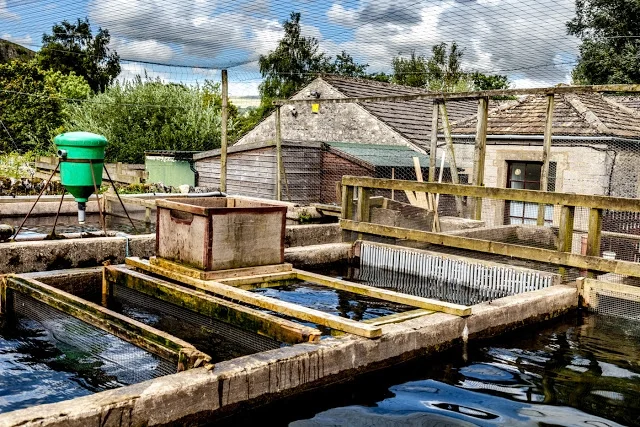In the distance a towering, overhanging limestone cliff, known as Kilney Crag looms above the road and towards the River Wharfe. White clouds scud across a wide, blue sky above this ancient landscape sculpted from craggy heather coated hills and rich, grass covered dales. In the distance I can see Mastiles Lane, the Roman road that would have formed part of the historic connection between Fountains Abbey and its lands in the Dales.
Kilnsey Park Estate has been raising trout for many years and its two large fresh water spring fed trout ponds are popular for fly fishing. A less well known gem in the crown of the estate is a small smokery situated by the trout raceways where fingerlings are raised to maturity in crystal clear, limestone filtered water that races down from the surrounding hills.
The smokery began in the 1980s and has gained a reputation among local food lovers for its small range of exquisite, traditionally smoked food. Earlier this year its reputation became national when its smoked duck achieved three gold stars in the prestigious Guild of Fine Foods, Great Taste Awards and its cold smoked trout received a gold star.
Like its Michelin counterpart, the Guild of Fine Foods, do not give their stars away easily. Of 10,000 products entered for the awards only 130 foods achieved the most coveted three star rating; that’s only one per cent.
I am here to meet Jamie Roberts, the managing partner of the estate who tells me “The inspiration behind the success of the Kinsey smokery is his mother Vanessa who learned how to smoke food from Jurg Bleiker, the founder of Bleiker's smokehouse situated in North Yorkshire. We use fine quality local ingredients raised here on the estate or sourced locally. The recipes used in preparing meat and fish for smoking are rooted in the history of the Kilnsey Estate.”
Jamie, who takes an active interest in local history says “The sense of history is strong in this part of the Dales. Cistercian monks arrived on the Estate gifted to them in 1155. For almost four hundred years the Craven area supported vast flocks of sheep and generated huge wealth for Fountains Abbey - until Henry VIII seized their lands at the Dissolution of the Monasteries. The monks were astute business men and Kilnsey hosted annual sheep gatherings where thousands of sheep were washed, sheared and traded - a tradition that continues at the Kilnsey Show today.
Merchants from across Europe came to Kilnsey to buy the high quality wool and in return the monks were able to purchase luxuries such as salt (which was vital for preserving food for the winter months) and spices which they used in elaborate dishes to impress their guests.
“It is hard to envisage colourful Venetian traders visiting the Yorkshire Dales but they would have been a familiar site here in the 16th century” says Jamie. “The salt and spices they brought with them were highly prized - in fact salt was so valued by the monks it was more expensive than gold.”
Salt was served in elaborate silver or pewter salt cellars, strategically positioned on the table to indicate the status of the visitor. Spices such as mace, cinnamon and nutmeg from the spice Island of Indonesian were also used to flavour food for elaborate feasts which the monks used to host here”
Drawing on Kilnsey’s long history Jamie is working on plans to expand the range of food the smokery produces. A new premium line of free range sausages, chicken and Yorkshire cheese will join the exisitng award winning smoked duck and trout. I was given the chance to sample each of the new products all of which were superb - just great for simple, but impressive meals for family and friends.
Like the monks, the Yorkshire Holy Smokery is sourcing its produce from the surrounding green valleys. The recipes used to prepare the smoked ingredients are being carefully researched with the help of a local food historian to reflect the use of some of the ingredients and methods the monks would have used during the middle ages.
These include fresh herbs such as tarragon, spices including mace and cardamom and wild native fruits such as sloes and juniper. Today the Estate keeps its own bees, which feed on the blooming heather which covers the expansive Wharfedale moorland in late summer - just as they did in monastic times. The smokehouse has been experimenting with using mead (an ancient liqueur brewed from honey) as a flavouring .
“Smoking food is about much more than lighting a fire and sitting back for the smoke to work its magic on the food - for instance the type of wood used to smoke the food creates subtly different flavours” says Jamie. Whereas most commercial smokehouses use oak or beech Jamie is exploring other local woods to see if they work.
“We are exploring the use of Rowan trees which were considered holy and could only be used for religious purposes. They were also associated with Saint Brighid the patron saint of spinning and weaving and used to make spinning wheels.”
Using smoke to preserve meat and fish is an ancient craft and, in the days before fridges, it was a principle method of food preservation. The time honoured smoking process begins now as it always has with salting fish and meat in a solution of brine infused with combinations of natural, aromatics to suit the inherent flavour of the food.
After salting, the food to be smoked is placed on racks in the smokery where wood shavings are set alight. The smoke house here at Kilnsey is a smallish, dark room lit from a picture window to one side. Through it there is a beautiful view of the surrounding Estate. The smoking kiln stretches along the back wall of the room. Woodsmoke billows through the oven, gently infusing the food. Today smoking food is as much about developing different flavours textures as preserving the food.
Jamie’s plan to expand the range of smoked food on sale from the estate is timely. Smoking food is undergoing something of a renaissance, as talented chefs and specialist restaurants realise its almost limitless potential to add flavour and texture to food.
Paul Rawlinson, owner of the acclaimed Nordic, Harrogate based restaurant Norse says “Yorkshire and Nordic countries have a lot in common in terms of how food was smoked and preserved in the past. Smoking food gives chefs the opportunity to be inventive with flavours. Two of our most popular dishes are smoked Jerusalem artichoke puree spread on bread and scattered with puffed buckwheat and a pudding of smoked fudge sauce with coffee cake. People are interested in the revival of traditional techniques, connecting with nature and eating local food. Smoking food is also relatively simple to do at home.”
The link with the Cistercian monks inspired Jamie to come up with a new name - The Yorkshire Holy Smokery - and the latest range of products will be launched early in 2016.
In researching this article I discovered many well known smoke houses are located on industrial estates. Very different from beautiful well sustained environments like this
I asked Jamie how he thought The Yorkshire Smokery differs from other smoke houses. “ We pride ourselves on being a small scale family run smoke house which will produce excellent quality smoked food. Ever since my family came to live here we have had a strong commitment to looking after the Dales which includes taking care of a wildflower nature reserve, breeding red squirrels and generating green energy from water and the sun. And we welcome visitors who can see for themselves the environment in which our food is produced.”
This is just the place to rear and process food I thought as I took a final glance up at the magnificent Kilnsey Crag and the limestone landscape before leaving for home.
Five key facts about the Kilnsey Estate
- The Kilnsey Park Estate has been in the Roberts family for four generations. It was bought by Jamie’s great, great, grand father Betram Roberts in 1911. Bertram Roberts was the son of Sir James Roberts who in 1893 took over the running of the famous Salt’s Mill from the family of its founder Sir Titus Salt
- The Kilnsey Crag Race, held annually in late August is widely recognised as the most spectacular fell-race in the country.
- The Kilnsey Angling Club was established in 1840 and is the second oldest angling club in the UK
- Kilnsey is home to the UK’s rarest wild flower - the Lady’s Slipper orchid and hosts the annual Wild About Orchids Festival
- The Kilnsey Show is one of the regions largest agricultural shows and has been taking place for almost 120 years. It attracts about 1500 visitors annually.
For an update on the plans for the Yorkshire Holy Smokery and visitor details www.kilnseypark.co.uk
This article was published in the Yorkshire Post Magazine December 6th 2015.







